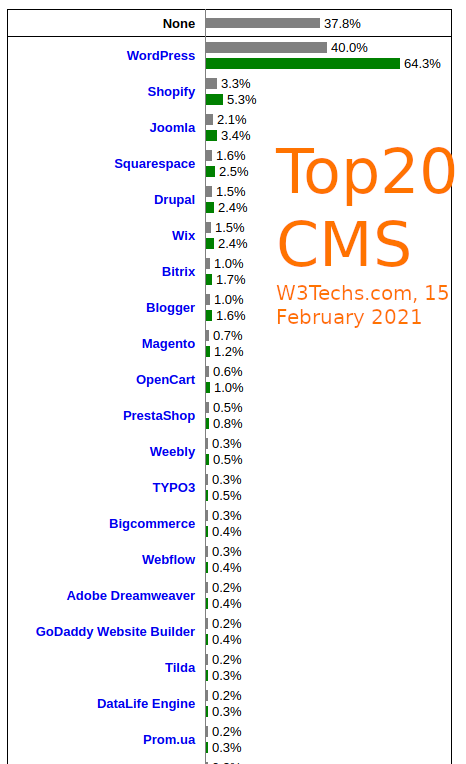“First Things First”
“Welcome.”
“WordPress is a very special project to me.”
“Every developer and contributor adds something unique to the mix, and together we create something beautiful that I’m proud to be a part of.”
“Thousands of hours have gone into WordPress, and we’re dedicated to making it better every day.”
“Thank you for making it part of your world.”
comment:
- this is wonderful (from the readme.html that comes with every installation and every update of wordpress but is often overlooked)
- wordpress is a success story of Open Source software
- the web would be more content empty and users would have less content to search and browse for (so Google should be VERY happy that WordPress exists) (exactly 35% of all content available in the world wide web is provided by wordpress (and of course wordpress would not run without the ever better-faster PHP + GNU Linux webservers & databases).
that once the user managed the setup and the massive-left-screen-side menu, becomes a breeze to publish content with (design & layout is a different story, but that’s not wordpress fault, imho many users probably would like to have:
- mobile friendly layouts (which wordpress now has per default themes)
- while at the same time…
- possibility to “layout like a pro” in a “adobe indesign” kind of desktop publishing fashion, but imho because the web and html originated from a physics and science (pure data driven) department, beauty and layout did not matter at those times… and thus up to this day, layout is not one of the strong features of html (even with css, js should NEVER be used for layout purposes)
- the first webserver, the first file.html, “the web” as users know it was invented in the 1980s by …
- “…physicist Tim Berners-Lee, a contractor at CERN, proposed and prototyped ENQUIRE, a system for CERN researchers to use and share documents. In 1989, Berners-Lee wrote a memo proposing an Internet-based hypertext system.[3] Berners-Lee specified HTML and wrote the browser and server software in late 1990. That year, Berners-Lee and CERN data systems engineer Robert Cailliau collaborated on a joint request for funding, but the project was not formally adopted by CERN. In his personal notes[4] from 1990 he listed[5] “some of the many areas in which hypertext is used” and put an encyclopedia first.
The first publicly available description of HTML was a document called “HTML Tags”, first mentioned on the Internet by Tim Berners-Lee in late 1991.[6][7] It describes 18 elements comprising the initial, relatively simple design of HTML. Except for the hyperlink tag, these were strongly influenced by SGMLguid, an in-house Standard Generalized Markup Language (SGML)-based documentation format at CERN.
- Eleven of these elements still exist in HTML 4.[8]“(src)
The wordpress readme.html continues like…
Final Notes
- If you have any suggestions, ideas, or comments, or if you (gasp!) found a bug, join us in the Support Forums.
- WordPress has a robust plugin API that makes extending the code easy. If you are a developer interested in utilizing this, see the Plugin Developer Handbook. You shouldn’t modify any of the core code.
Share the Love
WordPress has no multi-million dollar marketing campaign or celebrity sponsors, but we do have something even better—you. If you enjoy WordPress please consider telling a friend, setting it up for someone less knowledgable than yourself, or writing the author of a media article that overlooks us.
WordPress is the official continuation of b2/cafélog, which came from Michel V.
The work has been continued by the WordPress developers.
If you would like to support WordPress, please consider donating.
License
WordPress is free software, and is released under the terms of the GPL version 2 or (at your option) any later version. See license.txt.
keep it up 🙂
Links:
liked this article?
- only together we can create a truly free world
- plz support dwaves to keep it up & running!
- (yes the info on the internet is (mostly) free but beer is still not free (still have to work on that))
- really really hate advertisement
- contribute: whenever a solution was found, blog about it for others to find!
- talk about, recommend & link to this blog and articles
- thanks to all who contribute!



